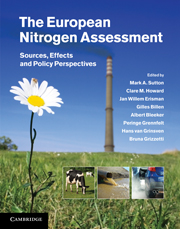Book contents
- Frontmatter
- Contents
- List of contributors
- Foreword
- Summary for policy makers
- Technical summary
- 1 Assessing our nitrogen inheritance
- Part I Nitrogen in Europe: the present position
- Part II Nitrogen processing in the biosphere
- Part III Nitrogen flows and fate at multiple spatial scales
- Part IV Managing nitrogen in relation to key societal threats
- Part V European nitrogen policies and future challenges
- Glossary
- Index
- References
1 - Assessing our nitrogen inheritance
Published online by Cambridge University Press: 16 May 2011
- Frontmatter
- Contents
- List of contributors
- Foreword
- Summary for policy makers
- Technical summary
- 1 Assessing our nitrogen inheritance
- Part I Nitrogen in Europe: the present position
- Part II Nitrogen processing in the biosphere
- Part III Nitrogen flows and fate at multiple spatial scales
- Part IV Managing nitrogen in relation to key societal threats
- Part V European nitrogen policies and future challenges
- Glossary
- Index
- References
Summary
A new challenge from a past solution
Human perturbation of the nitrogen cycle represents a major example of global geo-engineering. Historically, the limited availability of reactive nitrogen compounds has provided a key constraint to human activities. Although the element nitrogen is extremely abundant, making up 78% of the Earth's atmosphere, it exists mainly as unreactive di-nitrogen (N2). By contrast, to be useable by most plants and animals, reactive nitrogen (Nr) forms are needed. These include oxidized and reduced nitrogen compounds, such as nitric acid, ammonia, nitrates, ammonium and organic nitrogen compounds, each of which is normally scarce in the natural environment.
The two main historical needs for reactive nitrogen have been to provide fertilizers to increase food production and as a basis for the manufacture of munitions. Biological nitrogen fixation has always added new reactive nitrogen into the system, but the inputs have been barely sufficient for human needs. As a result, traditional agricultural production was highly dependent on effective recycling of nitrogen in manures.
By the end of the nineteenth century, an increasing human population combined with expanding military needs required that large amounts of extra reactive nitrogen be added into circulation. These demands were met by increased mining of reactive nitrogen deposits, including Chile saltpetre and guano, supplemented by the extraction of reactive nitrogen from coal and peat (Vincent, 1901; Clow and Clow, 1952; Watt, 2003; Sutton et al., 2008).
- Type
- Chapter
- Information
- The European Nitrogen AssessmentSources, Effects and Policy Perspectives, pp. 1 - 6Publisher: Cambridge University PressPrint publication year: 2011
References
- 16
- Cited by

